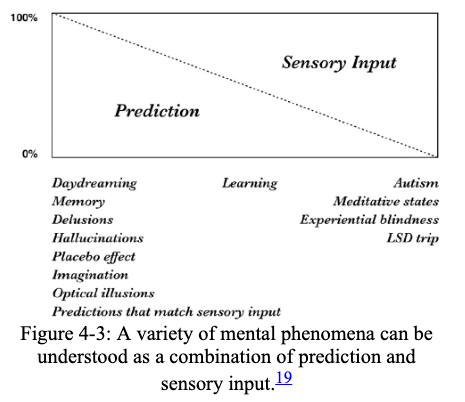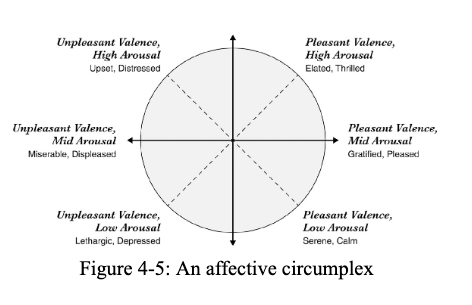[book] How Emotions Are Made
author: Lisa Feldman Barrett

Feb 2023
Summary
What we think of as “emotions” are not physiological entities that can be identified with brain scans or other biometrics. A crude summary, “there’s no such thing as emotion”, or “emotions are all in your head” would be an uncharitable version of the author’s thesis. What we call “emotion” is a complicated interaction between real bodily sensations (heart rate, stomach butterflies, blood pressure, facial changes) and the various interpretations that our culture has assigned to them. What’s really happening is that the brain, overwhelmed by the torrent of information coming at it, is forced to simplify. What we call “consciousness” is the brain generating short-term predictions of what is likely to happen next, and then modifying those predictions based on the sensory input it receives. Children learn very early to communicate the success or failure of predictions through facial changes and other indications that we interpret as emotion.
The author summarizes the consequences of this intriguing ideas, with some original suggestions for handing illness (“work to improve your emotional granularity – using more expressive words to describe your situation”), a prediction that AI won’t be able to identify emotions based on facial expressions, and the conclusion that our legal system would be fairer if we take emotional state out of our judgements.
Takeaways
- Work on improving your “emotional granularity”: the ability to distinguish among a multitude of emotions. Increase your vocabulary to say
- Categorize sensations with greater granularity. Instead of “I’m scared of spiders”, say “I’m disgusted by nerve-wracking spiders”.
- Change your location (what I call a “context switch”). E.g. 15% of Vietnam War-era soldiers were addicted to heroin when they were in the field, but 95% had recovered after a year back in the US.
- Practice techniques like recategorization : look at an object (like a lamp) and describe it in terms of its parts, or other attributes like the way light comes off it.
- “Pain is weakness leaving the body”
- Microsoft, Emotient, and others are wasting their time trying to read emotions through facial recognition
- Animals don’t have emotions, except in the sense that we socially apply emotions to them.
There are no objective fingerprints of emotion
She challenges the Tomkins experiments, where a standard expressive image of a face is shown to people around the world who are asked to select from a set of emotions to describe the face. Although this experiment has been widely replicated, it doesn’t seem to work using a more objective measure of muscle movement.
Camras and Oster did experiments with infants that appear to discredit the emotional theory further. Although adult observers tend to reliably assign emotions to infants’ faces, a closer look shows the observers are actually basing their description on the context: when a baby is shown a mean-looking gorilla doll, the baby gets classified as “scared”
When it comes to emotion a face doesn’t speak for itself.
Feldman-Barrett’s experiments show that much of our emotional interpretations are driven by culture. When we see expressive behavior in a movie, much of what we see is actually a trope. Popular cinema has trained us to expect that, for example, a man in a business suit is likely to be greedy, a Bible-thumping preacher is likely to be a hypocrite, and much more. It’s the context, not the facial expressions alone, that are driving our interpretation of the scenes.
Ekman, Levenson, and Friesen’s 1983 study, using machine-measured changes in biometrics, seemed to prove a link with emotions, but they used facial poses – ask the subject to make and hold a particular facial expression representing an emotion.
Meta-studies that try to link many different physiological changes with emotion fail to find consistent patterns.
Emotions are constructed
Your brain is constantly generating a simulation of the world, based on whatever feedback it gets its various sensors including your own heart rate. Emotions, like much of the rest of the way you perceive reality, are constructed out of those sensory inputs based on a ton of other factors, notably the cultural milieu in which you grew up.
In addition to social construction (i.e. societal conventions like “Pluto is a planet”), consider psychological construction (which is her claim about emotions being driven internally) and neurological construction (a consequence of neuroplasticity, whereby neurons are actually generated on the fly in order to preserve a particular state of memory)
As her counter to the big, heavily replicated experiments by Tomkins, Ekman and others, she notes flaws in the ways the experiments are set up.
Yes, if you show a facial photograph to somebody and ask them to choose among a limited set of pre-selected terms to describe the emotion, they tend to zero in on the the same interpretation. But the rate of agreement drops considerably if you leave the question open-ended. As proof, she shows a photo of Serena Williams: when you are primed to suspect anger in that face, that’s what you see. But when you are told the photo was taken after she won her championship tennis match, you suddenly interpret the expression as a exhilaration after a victory.
Her student was unable to replicate an experiment on the remote Himba tribe, despite following identical protocols. She explains this by noting that the original experiment included an elaborate “warm up” session that she says ruined the objectivity of the subjects. When the warm-up was eliminated, the non-western subjects gave entirely different interpretations to the photos.
Russell and Widen found that two- and three-year-olds used crude emotion terms “sad”, “mad”, and “scared” interchangeably, often distinguishing among them simply by whether the teeth are exposed or not.
The classicist and Roman specialist Mary Beard notes that Romans didn’t have a word for “smile”, which instead was an invention of the middle ages1
The author disputes the essentialist assumption she thinks is behind much of the misguided ideas about emotion. Thinkers from Darwin to William James to Steven Pinker all mistakenly think there is some fundamental essence – a Platonic form – to our emotions, likely hiding in a gene someplace.
Research on children shows that essentialist assumptions are innate: give a child a red cylinder called a “blicket” that lights up a machine and he will assume that a blue square by that name also works, even when another red cylinder nearby but not called by the same name. We assign functions and categories based on the names we give them.
Prediction is the brain’s primary mode of operation
Interoception, one of the core ingredients of emotion, is the overall sensation you have of being a living body with various internal activities like heartrate or breathing.
We operate on a “prediction loop”: predictions give rise to internal brain simulations, with are compared to expectations based on previous experience and then any errors are resolved.
Any mismatch between prediction and the input from sensors

Affect is our general sense of feeling, roughly divided between valence (how pleasant or unpleasant it is) and arousal (calm vs. agitated)
Russell’s circumplex 
Young Americans tend to prefer the upper-right quadrant, while older people (and many Chinese/Japanese) tend to prefer the lower-right.
Gerald L. Clore studies “gut feelings” also known as affective realism
The phrase “an unpleasant image” is really shorthand for “an image that impacts my body budget, producing sensations that I experience as unpleasant.”
Helen Mayberg uses deep brain stimulation to “turn off” treatment-resistant depression. By sending electrodes into the parts of the brain that control prediction, they can directly manipulate the body budgeting.
The myth of the “triune brain” says that are brains are made of a subcortical basic survival unit, on which sits a limbic “emotional” brain, on which sits a rational brain.
The world is continuous, not discreet
A rainbow’s colors don’t neatly divide into units from “red” to “blue”. Like most of the constructed world, color names are the categories we apply based on social and cultural conventions. The same is true of emotion.
Emotions and illness
Your “Body Budget”: To successfully navigate the ever-changing situations you encounter, the body is constantly making predictions of how to spend its “budget”: the bundle of dials and knobs that need adjusting in order to reach and maintain an equilibrium of health.
Many diseases are failures of the body to make those predictions successfully. Prolonged failure results in chronic disease.
Stress is chronic mis-budgeting. Your body, relying on the brain’s anticipation of future problems, spends its budget on compensatory factors, like raising the heart rate or the hunger reflex.
Depression is when past experiences inform predictions for the future that are not corrected by the present. Negative thoughts don’t cause negative feelings – negative feelings (in the past, that go uncorrected by present circumstances) cause negative thoughts.
Anxiety is the opposite of depression: future predictions contain too much uncorrected error, and the body budget freezes.
Importantly, these conditions aren’t “all in your head”, since they derive from physical changes in the body. There’s a complex interaction between predictions and corrections as the body tries to achieve homeostasis, and sometimes that interaction goes haywire.
Autism is a disorder of the brain’s ability to make predictions.
TIL: Until the mid-1980s, standard medical science assumed babies can’t feel pain – and operations were routinely performed without anesthesia. Even today most circumcisions assume the baby will be fine without painkillers.
updates
See biologist Jaak Panksepp, who disagrees based on evolutionary theory.
Footnotes
1. I challenge this quote from the book. At least in the literal sense, Latin “risus” or Greek “δακρύζω” “And consider this fun fact: the historical record implies that ancient Greeks and Romans did not smile spontaneously when they were happy. The word “smile” doesn’t even exist in Latin or Ancient Greek.”↩︎